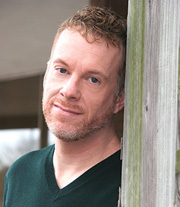Weird Science
A longtime activist observes that science, behavioral science, and university research has replaced community experience and input in HIV prevention. The gay community has especially suffered.

By Eric Roland
Photo by John Conroy
Over the past few years, here in Houston and in other urban areas across America, gay men have been asking, “What happened to all of the HIV-prevention services?” Men have said that they don’t see the bowls of condoms available at bars that were once readily available. They’ve also made comments about the lack of uniformed outreach workers spreading the messages of safe sex and handing out plastic baggies containing condoms, lube, and sometimes even a breath mint. Just last week, I read an e-mail from a local gay man who complained that free HIV testing at community organizations was very limited.
It’s true. HIV/AIDS-prevention services have been diluted, and that fact is impacting gay communities across the country. The Centers for Disease Control (CDC), responding to pressure from the Bush administration, has revamped the ways HIV-prevention services can be conducted using federal funds. In order to be held accountable to Congress, the CDC has mandated that community organizations choose from a short menu of scientifically proven HIV-prevention programs. Most of them come with catchy names or acronyms such as MPowerment or Many Men, Many Voices, abbreviated 3MV. Some of them even come with instruction kits so that community organizations don’t have to think outside the box. The CDC calls the project the Diffusion of Effective Behavioral Interventions, or DEBI for short. The program website, www.effectiveinterventions.org, describes more about the 14 CDC-endorsed HIV-prevention programs, only three of which are designed specifically for gay men.
This development arrives at an unfortunate time. HIV-infection rates are rising among gay men, especially young gay men who have not heard the “wear a condom every time” message that was a gay man’s mantra in the ’80s and ’90s. They’re coming out of high schools that, as mandated by the Bush administration, only teach abstinence. They’re hanging out at bars and on the Internet, where information on HIV is only available if you search for it. Experts say we’re headed for a second wave of HIV in the gay community.
—————————————–
Many people don’t remember the early days of AIDS in America. The sense of urgency was abundant. People talked. People were scared. Community organizations were formed to respond to the needs. They educated about safe sex. They took care of their own.
Thus, HIV/AIDS prevention was born. Media campaigns stressed the importance of using condoms. Town hall meetings were held to raise awareness of the devastating disease. Workshops were developed to educate the community on how the virus was transmitted and how it was not transmitted. Groups went into the community where gay men congregated and told them about the disease and distributed mass amounts of condoms. All of this activity embodied the true meaning of grassroots.
Because of discrimination against people with AIDS and gay men, the gay community formed small organizations or redeveloped existing agencies to take care of their own. They developed and maintained their own HIV-prevention programs using volunteers and raised their own funds to support the programs created for the community by the community. As new information became available, they were there to update the community quickly. They worked with local gay publications and radio shows to get the word out en masse.
Here in Houston, Montrose Clinic (now known as Legacy Community Health Services) and Montrose Counseling Center, both founded in the late 1970s, completely changed course when AIDS hit. Then in 1982, AIDS Foundation Houston was founded as the first organization in Texas dedicated solely to HIV-prevention education and services.
When the HIV test became available in the mid-’80s, state and local health departments offered the test. But after learning that the most at-risk gay men weren’t testing at the city-run public health clinics, these departments funded community-based organizations to conduct the test. These organizations insisted that testing had to be offered anonymously, knowing that many would not test without anonymity. The risk of losing health insurance or a job was a real threat, and many had heard talk of the government quarantining people with AIDS.
The local health department gradually took note of and funded successful workshops and outreach programs that these grassroots organizations had developed using community input. Even the federal government considered community input essential to the success of HIV prevention. In 1993, federal policy mandated that all the federally funded health departments use a community planning process for HIV prevention. According to the CDC, HIV Prevention Community Planning is a process by which people from different walks of life and with different interests, responsibilities, and involvement in HIV prevention come together as a group to plan ways to prevent HIV infection where they live.
Everything started to change in the new millennium. The Bush administration began shifting funding toward abstinence-only programs. Congress wanted proof that federal spending for HIV prevention was worthwhile. At the time, the AIDS epidemic was 20 years old.
In response, the CDC began reining in community input and endorsing science. All of a sudden, university researchers and behavioral scientists became the heroes of HIV prevention. Their research pointed to reductions in HIV infections for people who participated in their programs and had been published in academic journals. Smart people in hallowed halls, it seemed, knew more about preventing HIV than those who worked directly with the people most at risk and those living with the disease.
Community-driven HIV-prevention programs were no longer the gold standard. Instead, community organizations have been forced to use these effective behavioral interventions with the cute name—DEBI.
At the CDC-sponsored National HIV Prevention Conference in Atlanta last December, DEBI was a primary topic of discussion. Many researchers presented elaborate graphs to promote their latest proven methods for changing peoples’ high-risk behavior. Also present were representatives from community-based organizations who aren’t convinced DEBI offers all the answers.
As with most research, behavioral science research is heavily structured, incorporates excessive amounts of documentation, and is strictly monitored by minions of research students clamoring to get their names published. No doubt the research proves that certain techniques and methods actually do help people change their behavior, but the translation from the research lab to the real world is difficult to attain, especially with the limited funding that community organizations receive from government grants.
The research studies that backed up these DEBI programs usually handed out handsome monetary incentives to people who participated in the research. The kits that accompany some of these DEBIs instruct community organizations to replicate the program exactly as stated, allowing only limited adaptations. However, the kits never instruct organizations to hand out the generous incentives used to recruit participants in the research study. Instead, they suggest using gift cards in small denominations from local retailers.
Likewise, a few of the DEBI programs were proven successful using degreed psychotherapists or even medical doctors to work with high-risk individuals or people living with HIV/AIDS. These highly educated and well-paid individuals may be affordable with big-budget, federally funded research grants, but are hardly feasible in small community organizations.
Some of these studies were proven to work in very specific settings and communities. Research studies targeted to gay and bisexual men were often conducted in well-organized, cohesive gay communities, like San Francisco, while others were confined to gay bars in small cities like Birmingham, Alabama. The CDC expects each of these interventions to translate to any other city in America, but as we know there are grand differences between gay communities in Anchorage, Alaska, and Houston, Texas.
Community representatives also point to the time it takes to design, conduct, complete, and publish the research used to support DEBI. Some of the research was tested in the mid-1990s, yet is still expected to be effective 12 years later. Much has changed in 12 years. Gay men had barely heard of the Internet in 1995. Now there are at least as many, if not more, high-risk hookups online as there are in the bars or bathhouses. So while researchers were trying to prove that the 1990s AIDS-battle-weary gay man could be educated by his peer at the local bar, gay men took to staying home and chatting with their peers online. Unfortunately, DEBI is not Internet savvy, and there are no CDC-endorsed programs that use the Internet to reach at-risk people.
Let’s face it: DEBI is just not doing it. DEBI is proscriptive, expensive, often outdated, and not always based in reality. Not only does the HIV/AIDS epidemic change over time, people change, society changes, and technology changes. Community organizations see those changes first hand, often anticipating them before they actually happen. But each DEBI is resistant to change, remaining static and confined to a box. Community organizations should be allowed to design their own programs with input from their communities. Certainly, these organizations need guidance and structure to assure that HIV-prevention programs are reaching the right people and impacting their behaviors. And they should of course base their programs on theories and principles learned through the academic research process. But these organizations should not be constrained to scientifically proven programs that come with a kit.
MORE HIV REPORTS
Other topics discussed at the National HIV Prevention Conference in December included these:
• African-American gay and bisexual men are seven times more likely than their white counterparts to be infected with HIV. The reason for this is unclear, in light of new research suggesting that black men are no more likely to engage in high-risk sex and are actually less likely to use street drugs than white men who have sex with men (MSM). The sharpest increase in HIV diagnoses is occurring among young black MSM, notably those in their teens and early 20s.
• Use of crystal methamphetamine and other party drugs, such as ecstasy, ketamine, and GHB, has begun to decrease among gay and bisexual men in New York City.
• While sodomy is no longer a crime anywhere in the United States, states where such prohibitive laws remained in place until four years ago saw the fewest reductions in AIDS cases between 1995 and 2003.
• Detecting acute HIV infection, which often occurs two to six weeks after infection and is noted by flulike symptoms, may help to prevent disease spread. However, detection of acute HIV infection is expensive and may be limited to people in social/sexual networks where a new case of HIV has been detected.
• Studies indicate that safer-sex counseling by healthcare providers, such as doctors or nurses, leads to a decline in unprotected anal or vaginal intercourse in HIV-positive patients.
• A significant percentage of newly infected and diagnosed HIV-positive people had a history of serious mental illness and alcohol and drug problems, according to a small San Diego-based study.
Eric Roland is the senior director of marketing for Legacy Community Health Services. For the past 11 years, he has worked in HIV prevention. He has attended four national HIV-prevention conferences, including the most recent one held in Atlanta in December 2007.
Got a comment?—[email protected].











Comments